English
中文
Contact Number
Email
 Enterprise WeChat
Enterprise WeChat WeChat Service Account
WeChat Service Account
This section describes optical materials.
Optical materials in the software are supported in all algorithms (FDTD, FDFD, and FDE).
The software provides diverse material data or models, including dielectric material, conductive material, model material, sampled-data material, nonlinear materials, and emerging hot materials, and allows users to define materials. The software includes a global material library and an editable project material library. In the project material library, users can add new materials, edit material parameters, manually fit material models, and check the fitting results of material models.
Users can add and edit materials by using scripts. See Script.
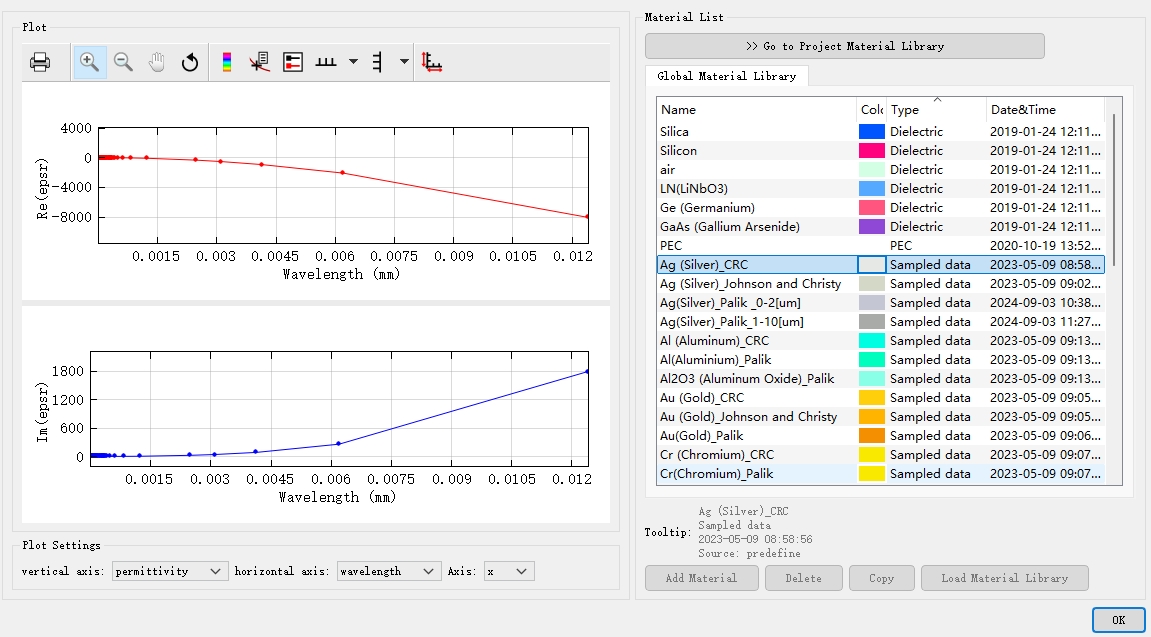
In general, we introduce the imaginary part of the refractive index, and use the complex refractive index to define the material:
Where, is the real part of , indicating the refractive index in the usual sense; is the imaginary part of , indicating the attenuation () or gain ().
The relationship between the complex permittivity and the complex refractive index is:
The colors and names of the materials in the material library can be set in the Material data tab.
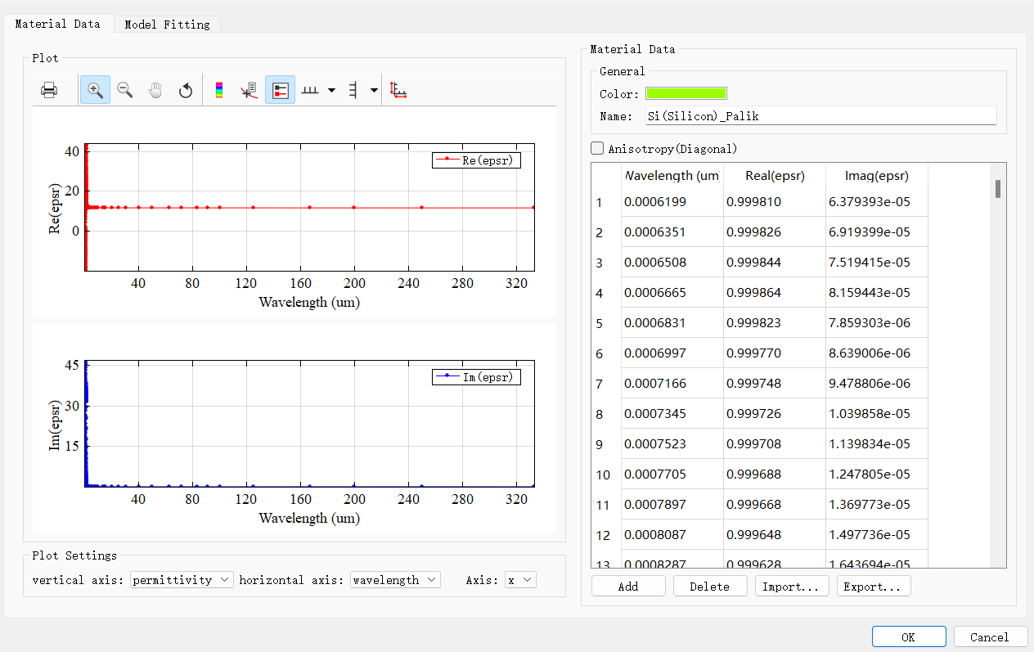
| Name | Default | Description |
|---|---|---|
| Color |  |
Specifies the color of the material. |
| Name | Untitled material | Sets the name of the material. It is a string type. |
According to the relevance between the refractive index of a material and frequency (or wavelength), materials can be divided into:
By the fitting algorithm, the material is used as a model in the project simulation.
Below is the Model fitting window.

This window displays tabs such as the material bandwidth range, fitting parameter settings, and fitting status. The RMS error is used to evaluate the effect of material fitting. For more details, please refer to the Material Fitting section below.
The software supports the creation of isotropic materials and diagonal anisotropic materials.
The mathematical expression for the dielectric constant of a diagonal anisotropic material is:
On the Material data page, select Anisotropy (Diagonal), and set respectively. This button is applicable to all material models (PEC is not supported). In the Plot window, switch the Axis of Plot settings to view material data in different directions.
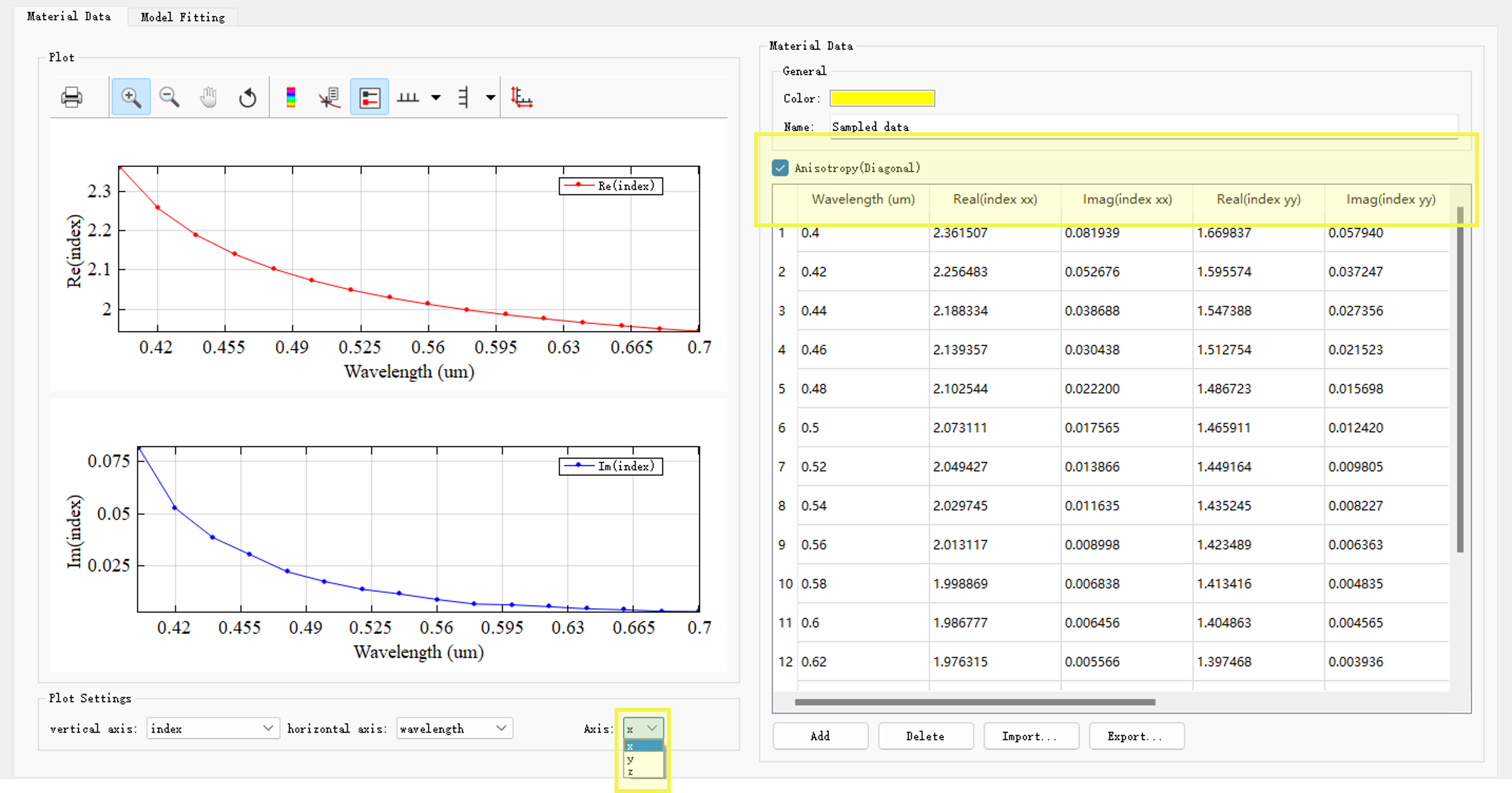
General anisotropic materials are not currently supported, namely:
In general, any material features nonlinear response; therefore, the nonlinear response is not a separate material feature. For ease of description, this section does not distinguish between nonlinear material and nonlinear response.
In software, a nonlinear material consists of a basic material and a nonlinear coefficient.
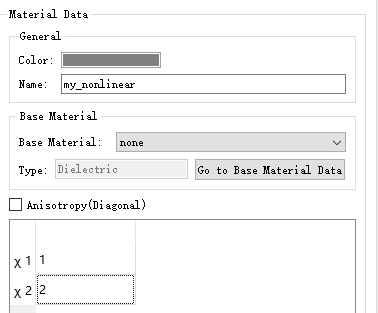
The software supports two types of nonlinear materials: Chi2 nonlinear and Chi3 Raman/Kerr nonlinear.
For more detailed settings, please refer to Nonlinear.
Currently, the software supports the following material models:
| Name | Description |
|---|---|
| Dielectric | Refers to a material with a constant refractive index, which is independent of wavelength. See Dielectric. |
| (n, k) Material | NK material refractive index , and nk material refers to the material at a single frequency point (or center frequency point). See (n, k) Material. |
| Conductive | Refers to a model describing a conductive material. The conductive material is frequency-dependent. See Conductive. |
| Conductive 2D | Refers to a model describing 2D conductive material. See Conductive. |
| Debye | Refers to individual particles that do not interact with each other (such as gases). The Debye model is frequency-dependent. See Debye. |
| Lorentz | Refers to a model describing a semiconductor material. The Lorentz model is frequency-dependent. See Lorentz. |
| Drude | Refers to a model describing plasma/metal materials. The Drude model is frequency-dependent. See Drude. |
| PEC | Describes a perfect conductor. See PEC. |
| Sampled data | Using the experimental data of the material. It can be fitted to a stable model of the material in the specified frequency band. See Sampled data. |
| Sampled 2D data | Using real experimental data of the 2D material. It can be fitted to a stable model of the material in the specified frequency band. See Sampled data. |
| Chi2 nonlinear; Chi3 Raman/Kerr nonlinear | Describes the nonlinear response of optical materials. See Nonlinear. |
| Graphene | Describes emerging materials, that is, surface conductive graphene model in the specified frequency band. See Graphene. |
| RLC | Describes lumped elements integrating with resistance ®, inductance (L), and capacitance ©. |
The library storing materials is the material library.
The software makes a strict distinction between Global material library and Project material library.
Global material library: Provides ideal model or experimental data for the most popular materials, including all supported material models. The contents of the Global material library are protected and cannot be modified by users;
Project material library: The fitted material models are saved with the project. Users can perform operations such as adding, deleting, or modifying in the Project material library according to their actual needs.
When constructing a structure, users can select materials from the Global Material Library in the material tab, and the selected material will be automatically added to the Project Material Library. Additionally, users can choose an appropriate material type in the Project Material Library based on actual material characteristics to add new materials. Different material types require different material parameters. For detailed information, please refer to the material model table above.
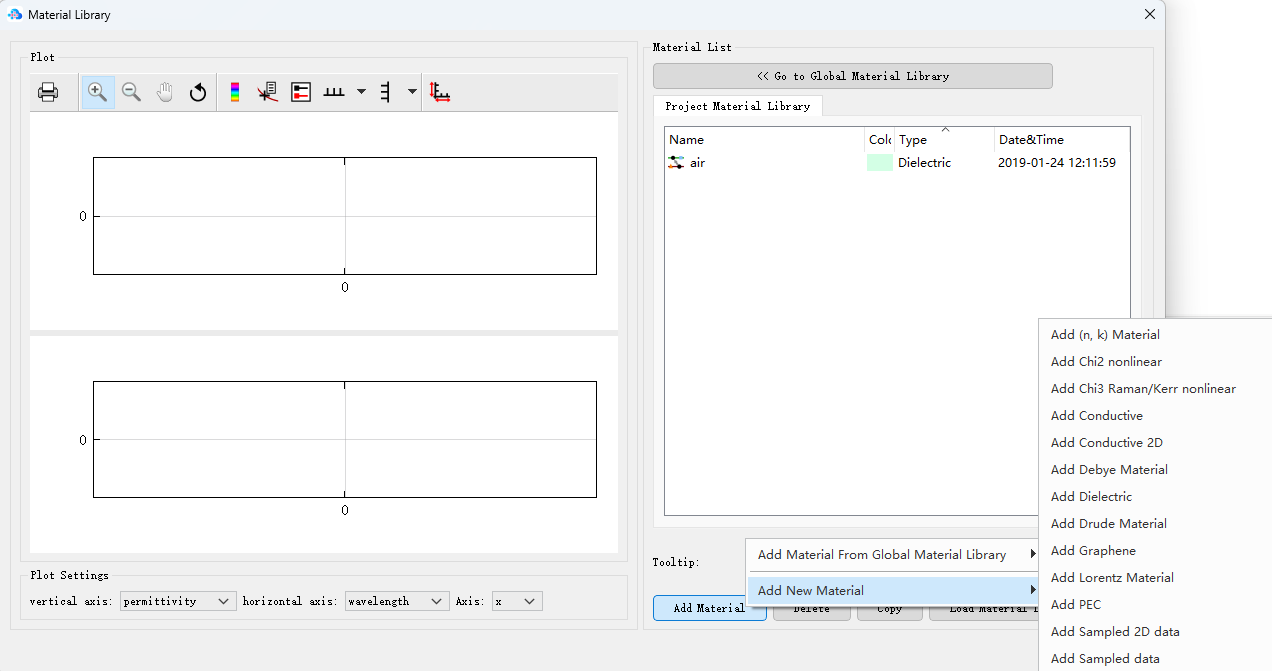
The software fits the experimental data of the material into a stable material model through the fitting algorithm.
The Material fitting window has the following settings:
| Name | Default | Description |
|---|---|---|
| Bandwidth Settings | Wavelength setting range | Bandwidth settings include the frequency/wavelength range of the material. By default, the bandwidth range displayed on this tab is consistent with the source. |
| Tolerance type | RMSE | RMSE (Root mean squared error) and RRSE (Root relative squared error) are the most significant parameters for characterizing fitting error. Definition methods are slightly different: , . |
| Tolerance | RMSE: 0.1 | Maximum allowable tolerance for material fitting. |
| Max coefficients | 6 | The allowed highest order in material fitting models (polynomials). |
| Improve FDTD stability | Selected | Improves the stability of the fitted model. |
| Imaginary weight | 1 | Imaginary weight for material fitting. |
| Ratio | 20 | One of the custom parameters of the PSO. By default, ratio does not need to be changed. |
| Max generations | 240 | The maximum number of iterations that need to be run, by default, does not need to be changed. |
| Generation size | 500 | The number of particles in each iteration, by default, does not need to be changed. |
The software provides the automatic material fitting methods for the fitting of material data.
flowchart TD
Choose_SampledMaterial[Choose material] --User define--> MaterialFitting[Material fitting program];
Lambda/Frequency-.Base on source.-> MaterialFitting[Material fitting program];
parameters[RMSE, Max coefficients]-.Default.-> MaterialFitting[Material fitting program];
Auto-fitting, that is:
The software provides parameters and images of the fitting results for the evaluation of the material fitting model.
flowchart TD
MaterialFitting[Material fitting program] -->Fitting_status[Fitting status];
MaterialFitting[Material fitting program] -->Figure;
Fitting_status --> parameters2[RMSE/RRSE, Max coefficients];
Fitting_status -->Lambda/Frequency;
Fitting_status -->Others[...];
Evaluation of the fitted model:
The software allows the modification of each parameter, including those in the advanced settings, to meet the fine-tuning requirements of the fitted model. However, this function is very complex, and is only recommended for advanced users, that is, those users who are in good command of the software material fitting settings. Otherwise, it may be counterproductive.
flowchart TD
Choose_SampledMaterial[Choose material] --User define--> MaterialFitting[Material fitting program];
Lambda/Frequency-.Base on source.-> MaterialFitting[Material fitting program];
parameters[RMSE, Max coefficients]-.Default.-> MaterialFitting[Material fitting program];
Custom fitting means that
Confirm the type of material required for the simulation before starting the simulation. The materials available in the Global material library can be added directly on the structure editing interface.
For other material types, you can create the model material in the Project material library window by choosing Add material > Add new material.
Right-click the structure, enter the Edit properties, and switch to the Material page. Click Add/Edit to enter the Project material library, and select the target material. Complete the process of assigning the material to the structure.
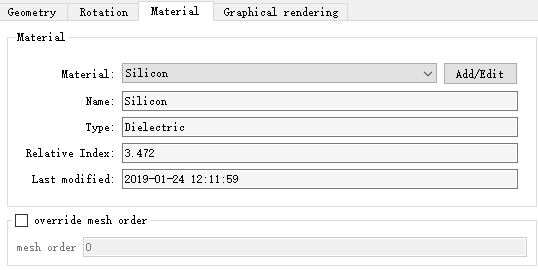
Different numerical solvers have their own complex set of solutions for the discretization of the structure and the assignment of material data. Checking materials is an important part of simulation inspection.
The software provides a variety of ways to inspect materials in different phases of modeling and simulation.
Global material library and Project material library
When creating materials, pay attention to two material libraries: Project material library is the material model library created by this project for simulation.
Select Model fitting tab in Project material library to evaluate the material models based on the graphics or data. See Material Fitting.
View the current mesh data
After the material is added to the structure, click View the current mesh data on the left toolbar of the software to visually view the distribution of the drawing material on the three-dimensional spatial mesh.
Index monitor
Index monitor allows users to accurately obtain graphics (and data) of material distribution at specified spatial locations, making it easy to check the correctness of material creation.
Negative refractive index material is an artificial optical structure, and the refractive index is negative in a certain frequency range. See Negative refractive index materials.